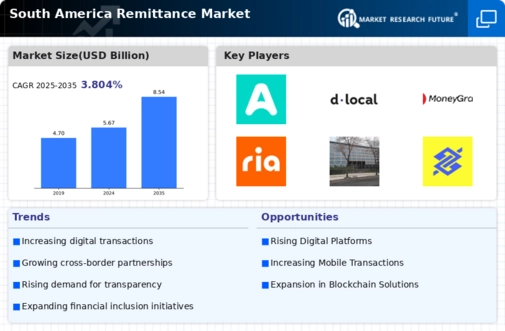The South America Remittance Market has become increasingly competitive due to the rising migration trends, economic factors, and technological advancements that facilitate money transfers. In recent years, the market has seen the entry of various players offering innovative solutions to meet the diverse needs of customers looking to send or receive money across borders. With the digitalization of financial services, established companies and fintech startups alike have emerged, each striving to enhance their service offerings, improve user experiences, and reduce transaction costs.
The competitive landscape is characterized by varying approaches to customer acquisition and retention, with some focusing on low-cost transfers while others emphasize speed and reliability. Understanding the dynamics of this market involves analyzing the strengths and weaknesses of the key players that have established a foothold in the region.Azimo stands out in the South America Remittance Market with its user-friendly digital platform that allows individuals to send money internationally with ease. Its service is particularly notable for its competitiveness in pricing and speed, which appeals to a cost-sensitive customer base.
Azimo has strategically positioned itself to cater to various demographics, providing options for cash pickups, bank deposits, and mobile wallet transfers, which enhances user flexibility. The company's strong focus on customer service, driven by a robust support infrastructure, further strengthens its competitive edge. Moreover, its ability to swiftly adapt to market changes and regulatory requirements bolsters its reputation in the region, making Azimo a formidable player in the South American remittance landscape.DLocal has carved a niche for itself in the South America Remittance Market, particularly by offering a comprehensive suite of payment solutions tailored for local consumers and businesses.
DLocal's strengths lie in its technology-driven platform that facilitates seamless online transactions and enables cross-border remittances. The company has established strategic partnerships with various local financial institutions, enhancing its payment capabilities across multiple countries. DLocal's key offerings include local payment processing, remittance solutions, and streamlined currency conversion services that cater to both merchants and individual users. The company has pursued a growth strategy through mergers and acquisitions, continuously expanding its market presence in South America and increasing its service offerings.
Its emphasis on compliance with regional regulations, along with its robust operational framework, allows DLocal to navigate the complexities of the remittance market, thereby solidifying its presence and gaining a competitive advantage.
























